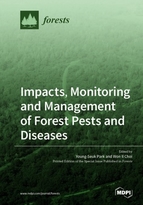Impacts, Monitoring and Management of Forest Pests and Diseases
A special issue of Forests (ISSN 1999-4907). This special issue belongs to the section "Forest Ecology and Management".
Deadline for manuscript submissions: closed (30 June 2019) | Viewed by 64637
Special Issue Editors
Interests: ecological modeling; community ecology; ecosystem monitoring and assessment; invasion biology; aquatic ecosystem management
Special Issues, Collections and Topics in MDPI journals
Interests: climate change; entomology; ecological modeling; forest pests; population dynamics
Special Issues, Collections and Topics in MDPI journals
Special Issue Information
Dear Colleagues,
Forest pests and diseases are severe disturbance factors in forest ecosystems. Forest pests and diseases have diverse negative impacts on the forestry economy, ecosystem service, biodiversity, and sustainable ecosystem management. Many forest pests and diseases are related with invasive species in many countries. To reduce their impacts, various management programs have been implemented by many countries around the world. Monitoring their occurrence and the assessment of their impacts are a first step to effectively manage forest pests and diseases. It provides basic knowledge about forest pests and diseases, as well as proper management methods. In particular, long-term monitoring programs for forest pests and diseases offer insights about forest pests and diseases with the aid of proper analysis tools. Moreover, the long-term data can provide clues to understand the influence of disturbances, such as climate change and invasive species on forest ecosystems. Based on the data from monitoring programs, new methods for monitoring, assessing impacts, and developing management techniques could be developed. An ecological model is an effective methodology for the management of forest pests and diseases. It can be used for providing information that is required for decision making through hazard ratings, the examination of potential impacts, and the prediction of dispersal patterns for forest pests and diseases. From academic points of view, it can also simulate the natural conditions to understand the cause of occurrence and decline of forest pests and diseases in ecosystems and evaluate the influence of various environmental factors on forest pests and diseases, and its effects on ecosystems. To provide a better understanding of the structure and processes in the forest ecosystems, and to provide fundamental information for effective management of forest pests and diseases, this Special Issue will accept studies from broad research topics related to impacts, monitoring, and management of forest pests and diseases, including case studies, methods, theories, and models.
Prof. Dr. Young-Seuk Park
Dr. Won Il Choi
Guest Editors
Manuscript Submission Information
Manuscripts should be submitted online at www.mdpi.com by registering and logging in to this website. Once you are registered, click here to go to the submission form. Manuscripts can be submitted until the deadline. All submissions that pass pre-check are peer-reviewed. Accepted papers will be published continuously in the journal (as soon as accepted) and will be listed together on the special issue website. Research articles, review articles as well as short communications are invited. For planned papers, a title and short abstract (about 100 words) can be sent to the Editorial Office for announcement on this website.
Submitted manuscripts should not have been published previously, nor be under consideration for publication elsewhere (except conference proceedings papers). All manuscripts are thoroughly refereed through a single-blind peer-review process. A guide for authors and other relevant information for submission of manuscripts is available on the Instructions for Authors page. Forests is an international peer-reviewed open access monthly journal published by MDPI.
Please visit the Instructions for Authors page before submitting a manuscript. The Article Processing Charge (APC) for publication in this open access journal is 2600 CHF (Swiss Francs). Submitted papers should be well formatted and use good English. Authors may use MDPI's English editing service prior to publication or during author revisions.
Keywords
- Alien species
- Forest pathogens
- Forest pest insects
- Hazard rating
- Impacts of forest pests and diseases
- Modelling approach
- Monitoring for forests pests and diseases
- Occasional pests and diseases
- Pest management
- Risk assessment







